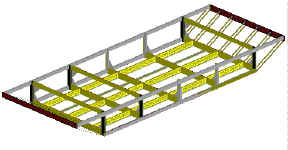
Hull frame for a scow shanty hull.
My framing plan is a variation of George Buehler's approach on River Walker and Rufus. It uses 2x6s, 2x4s, 1x4s and 1/2" ply gussets. I've altered is some, but it still seems like overkill to me in many ways. I'd appreciate all feedback. David Beede
3 bulkheads and 2 frames
A note on the frame construction. They're fastened with 1/2" ply gussets, PL Premium and Ring nails. Base is 2x6, sides are 2x4s notched for 2x4 chine and sheer, top of bulkhed is 2x4. The 2x6 bases are notched for 1x4 stringers. The notching for the stringers is pretty simple. The 2x6 bases are clamped together (prior to frame assembly) on edge and the notches are marked and cut out of all boards simultaneously using a circular saw or router set to the proper depth. Cut limber holes at this time too. Hull is built upside down, glassed and epoxied. Skid rails are mounted - bottom is sanded primed and painted, then the hull is rolled, ideally onto its trailer. (This will take a really clever block and tackle rig or a really big party.)
Materials estimate for scow hull:
22' x 8' - 24" sides (4" draft at 4000 lbs loaded)Weight estimate of materials in hull so far is 1180 lbs
1/2" ply - (1/2 Doug Ply=1.37 LB/SF)
6 bottom (not doubled, but joints fall on stringers and frames)
3 sides (might consider 3/8" Doug Ply=1.030 LB/SF)
2 for decks
1 for gussetts
3 cabin floor
15 - TOTAL (15 x 32 = 480 x 1.37 = 658 lbs )
lumber in frame:
Ideally Fir or Pine if available - I'll avoid spruce below the waterline due to not being very resistant to rot.
Pressure treat is usually southern yellow pine which George says is acceptable though sometimes heavy. I'll probably use it - see PL Premium test below.2x6s: (weights based on doug fir density of 30 lbs per cubic foot) - 124 lbs
72 linear feet (bulk heads & frames & bow and stern and keelson) can be 9, 8 footers
2x4 (linear feet in parentheses) 269 lbs
2, 16 footers for chines (32)
2, 8 footers for scow chines (16)
4, 12 footers for sheers (48)
3, 8 footers for bulkhead tops (24)
10, 8 footers for scow ends (80)
5, 10 footers for deck joists (50)
TOTAL LINEAR 250
1x4s
5, 16 footers for bottom stringers (TOTAL LINEAR ft - 80) 44 lbs
2x2s (total linear = 120 ft) 56 lbs
5, 16 footers for skid rails on bottom
5, 8 footers for skid rails on scow ends
4x4s 20 lbs
1 - 8 footer- corner mooring posts
bronze ring nails
-
approx. 1800 for the hull at 3 inch spacing - (hull only- about 10
lbs)
nails are about $5.50 lb
1 1/2" #12 nails - about 200 to the pound -
1" #12s are about 300 per pound
screws - 2 1/2" stainless or galvanized deck screws - or bronze boat screws?
PL Premium -
I tried a variation on Mike Goodwin's test. I used two 8" pieces of 2x6
pressure treat. Buttered the end grain of one and hand pressed it into the
middle of the other forming an inverted T. No clamping and no fasteners. Let it
set overnight. Challenge anyone to break the bond. Anything goes (except driving
over it with your car) you can use a wall, stand on it, throw it on the concrete
whatever. (Did I mention I love this glue!)
Finishing:
Sand paper (belts, disks and sheets)?
filler -?
Primer ?
Finish coat (latex or oil - quality exterior house paint or floor paint) ?
glass cloth?
epoxy?
(As a point of reference, Kit for fiberglassing for Water Lodge cost $384 for 20' $464 for 24' version)
Some more notes:
The sketch shows a 1 1/2" x 4 3/4" on edge of 3 of the 1x4 stringers, like multiple keelsons. A keelson is like an internal keel, giving rigidity but not directional stability or added draft. I show it duplicated on top of 3 stringers, instead of floor joists. Would lend great fore and aft rigidity but it might be overkill.
The framing of the scow ends and deck joists (not shown) are 2x4s edge mounted on 16" centers. The center of the scow ends can mirror the keelson
Also not shown, are the 2x2 skid rails which will go on after the bottom is glassed and will be renewable. They will be mounted with glue and screws, where the screws are removed after the glue sets. This allows for future removal and renewal using planing without the obstacle of fasteners. (Most planes prefer not to chew on metal.)

The gunwale rub rails are mounted in a gentle arc to define a simulated sheer. The cartoon drawing shows a 2x6 in straight line, but you see the raised bow effect. This will result in low bulworks on the bow deck and flush at mid sides, then small toe rail on stern deck.
Regarding storage:
In addition to all the usual cabinet,
shelf and furniture type storage, the below decks has an abundance of space for
adequately containerized stowage. The 1/2" ply floor can have opening
(of any size or shape) cut into them with a saber saw. (an angled blade can make
seating the lid easier) After removing the lid, a lip can be glued around the
inside edge of the opening to hold the lid in place. Drill hole through lid as
handle. Below the foredeck is sometimes used to store a roll or slide out bed.
The aft deck can be sealed from the cabin so you can store gas cans, ground
tackle and such.
Materials for cabin?
PLY:
1/4" sheets (1/4 DougPly=.687 LB/SF)
10 sheets for cabin sides (320 x .687 = 220 lbs) - Subtract area of window.
1/2" ply
- 4 sheets for cabin roof (175 lbs)Comments or questions? Email me.... David Beede